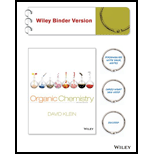
Interpretation:
The reaction mechanism which the given set of molecules favours should be determined.
Concept Introduction
Carbocation: It is carbon ion that bears a positive charge on it.
Leaving group: It is a fragment that leaves substrate with a pair of electrons via heterolytic bond cleavage.
Nucleophile: Donates pair of electrons to positively charged substrate resulting in the formation of
Nucleophiles are classified as strong and weak nucleophile depending on how readily the molecule donates electrons.
The nucleophilic character for the molecule depends on the size and the electronegativity of the atom present in the molecule.
(a)
Concept Introduction
Structure of the substrate plays major role in the reactivity of
Carbocation: it is carbon ion that bears a positive charge on it.
Leaving group: it is a fragment that leaves substrate with a pair of electrons via heterolytic bond cleavage.
Nucleophile: donates pair of electrons to positively charged substrate resulting in the formation of chemical bond. Nucleophiles are classified as strong and weak nucleophile depending on how readily the molecule donates electrons.
The nucleophilic character for the molecule depends on the size and the electronegativity of the atom present in the molecule.
(b)
Concept Introduction
Structure of the substrate plays major role in the reactivity of
Carbocation: it is carbon ion that bears a positive charge on it.
Leaving group: it is a fragment that leaves substrate with a pair of electrons via heterolytic bond cleavage.
Nucleophile: donates pair of electrons to positively charged substrate resulting in the formation of chemical bond. Nucleophiles are classified as strong and weak nucleophile depending on how readily the molecule donates electrons.
The nucleophilic character for the molecule depends on the size and the electronegativity of the atom present in the molecule.
(c)
Concept Introduction
Structure of the substrate plays major role in the reactivity of
Carbocation: it is carbon ion that bears a positive charge on it.
Leaving group: it is a fragment that leaves substrate with a pair of electrons via heterolytic bond cleavage.
Nucleophile: donates pair of electrons to positively charged substrate resulting in the formation of chemical bond. Nucleophiles are classified as strong and weak nucleophile depending on how readily the molecule donates electrons.
The nucleophilic character for the molecule depends on the size and the electronegativity of the atom present in the molecule.
(d)
Concept Introduction
Structure of the substrate plays major role in the reactivity of
Carbocation: it is carbon ion that bears a positive charge on it.
Leaving group: it is a fragment that leaves substrate with a pair of electrons via heterolytic bond cleavage.
Nucleophile: donates pair of electrons to positively charged substrate resulting in the formation of chemical bond. Nucleophiles are classified as strong and weak nucleophile depending on how readily the molecule donates electrons.
The nucleophilic character for the molecule depends on the size and the electronegativity of the atom present in the molecule.
Want to see the full answer?
Check out a sample textbook solution
Chapter 7 Solutions
Organic Chemistry, Binder Ready Version
- Provide steps and explanation please.arrow_forwardDraw a structural formula for the major product of the acid-base reaction shown. H 0 N + HCI (1 mole) CH3 N' (1 mole) CH3 You do not have to consider stereochemistry. ● • Do not include counter-ions, e.g., Na+, I, in your answer. . In those cases in which there are two reactants, draw only the product from 989 CH3 344 ? [Farrow_forwardQuestion 15 What is the major neutral organic product for the following sequence? 1. POCI₂ pyridine ? 2. OsO4 OH 3. NaHSO Major Organic Product ✓ OH OH 'OH OH 'OH 'CIarrow_forward
- Could you please solve the first problem in this way and present it similarly but color-coded or step by step so I can understand it better? Thank you!arrow_forwardCould you please solve the first problem in this way and present it similarly but color-coded or step by step so I can understand it better? Thank you!arrow_forwardCould you please solve the first problem in this way and present it similarly but (color-coded) and step by step so I can understand it better? Thank you! I want to see what they are doingarrow_forward
 ChemistryChemistryISBN:9781305957404Author:Steven S. Zumdahl, Susan A. Zumdahl, Donald J. DeCostePublisher:Cengage Learning
ChemistryChemistryISBN:9781305957404Author:Steven S. Zumdahl, Susan A. Zumdahl, Donald J. DeCostePublisher:Cengage Learning ChemistryChemistryISBN:9781259911156Author:Raymond Chang Dr., Jason Overby ProfessorPublisher:McGraw-Hill Education
ChemistryChemistryISBN:9781259911156Author:Raymond Chang Dr., Jason Overby ProfessorPublisher:McGraw-Hill Education Principles of Instrumental AnalysisChemistryISBN:9781305577213Author:Douglas A. Skoog, F. James Holler, Stanley R. CrouchPublisher:Cengage Learning
Principles of Instrumental AnalysisChemistryISBN:9781305577213Author:Douglas A. Skoog, F. James Holler, Stanley R. CrouchPublisher:Cengage Learning Organic ChemistryChemistryISBN:9780078021558Author:Janice Gorzynski Smith Dr.Publisher:McGraw-Hill Education
Organic ChemistryChemistryISBN:9780078021558Author:Janice Gorzynski Smith Dr.Publisher:McGraw-Hill Education Chemistry: Principles and ReactionsChemistryISBN:9781305079373Author:William L. Masterton, Cecile N. HurleyPublisher:Cengage Learning
Chemistry: Principles and ReactionsChemistryISBN:9781305079373Author:William L. Masterton, Cecile N. HurleyPublisher:Cengage Learning Elementary Principles of Chemical Processes, Bind...ChemistryISBN:9781118431221Author:Richard M. Felder, Ronald W. Rousseau, Lisa G. BullardPublisher:WILEY
Elementary Principles of Chemical Processes, Bind...ChemistryISBN:9781118431221Author:Richard M. Felder, Ronald W. Rousseau, Lisa G. BullardPublisher:WILEY





